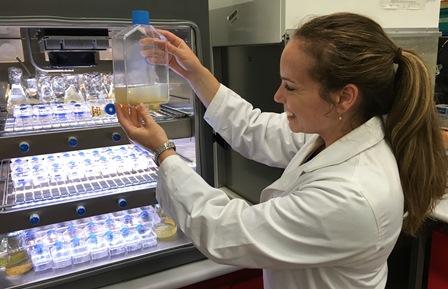
Her talk at the ASPAB conference outlined UTS research into microalgal species responsible for producing toxins that cause Ciguatera Fish Poisoning (CFP) in humans. A better understanding of the ecological niche of toxin producing epibenthic dinoglagellates is fundamental to reducing the risk of human exposure to CFP in a changing climate.
Michaela explains that it is only some microalgal species which produce potent toxins that can accumulate in the food web and, when consumed by humans, can cause illness and even death.
“Ciguatera Fish Poisoning arises from consumption of marine fish whose flesh and viscera have been contaminated with ciguatoxins produced by dinoflagellates from the genus Gambierdiscus, “ she says.
“Species from this genus are usually found in tropical reef environments and have been documented throughout the Great Barrier Reef, however in recent years a population of Gambierdiscus carpenteri was identified as far south as Merimbula, New South Wales.”
Monoclonal isolates of Gambierdiscus carpenteri were established from temperate Merimbula and species classification was confirmed using species-specific semi-quantitative polymerase chain reaction (qPCR) assays. Targeted Liquid Chromatography-Mass Spectrometry (LC-MS) analysis designed to detect toxins implicated in CFP occurrences revealed established strains of Gambierdiscus carpenteri from Merimbula do not produce toxins known to be associated with this illness. However, a high level of cytotoxicity toward the SH-SY5Y human derived neuronal cell line was identified using the neuroblastoma cell based assay suggesting the presence of an unknown toxic compound.
In order to characterise the thermal niche of this temperate Gambierdiscus carpenteri population, five strains were used to measure growth rate at six temperatures across a thermal gradient ranging from 15-30°C. The thermal niche width extended across all temperatures tested and the measured thermal optima (24-27°C) was found to be several degrees above the ambient average water temperature.
"As part of my PhD project, I have isolated over 20 strains of Gambierdiscus from multiple sites in Australia. Now, for the first time, there are cultures available to determine whether ciguatera producing dinoflagellates exist in Australia," Michaela says.
"Given that these organisms are notoriously difficult to maintain in culture, these strains are extremely valuable and it is important to confirm their identity and quantify their toxicity so they can be used in further research. I'm extremely grateful for the support from The Linnean Society and ASPAB."
Michaela is a member of the Coastal Oceanography and Algal Research Team led by Associate Professor Martina Doblin.
Understanding the Ecological Niche of Toxin Producing Epibenthic Dinoflagellates
Michaela E. Larsson, Kirralee G. Baker, Olivier F. Laczka, Kate Samardzic, Kenneth J. Rodgers, D. Tim Harwood, Shauna A. Murray, Martina A. Doblin

